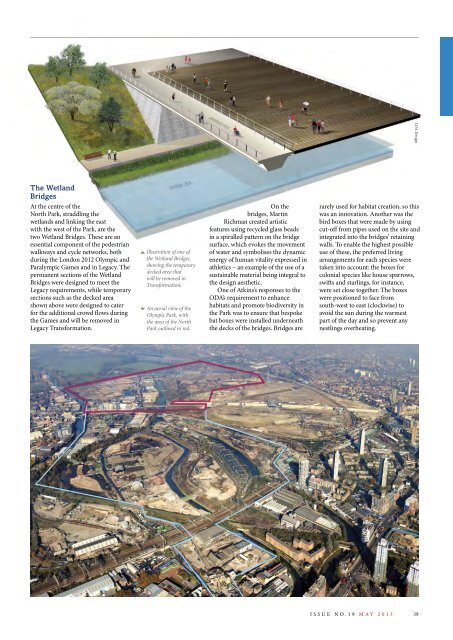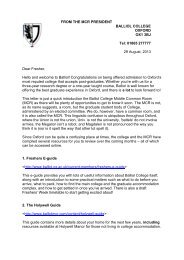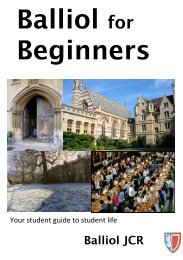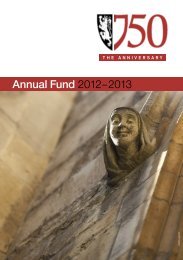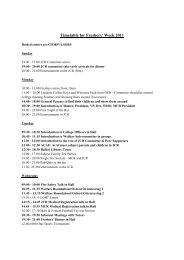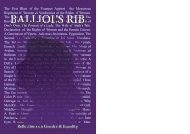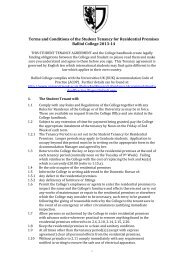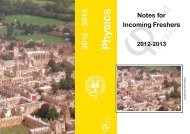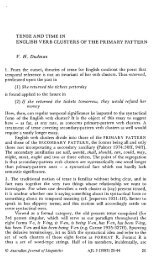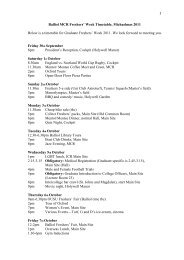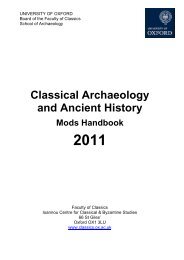Issue 19, 2013 - Balliol College - University of Oxford
Issue 19, 2013 - Balliol College - University of Oxford
Issue 19, 2013 - Balliol College - University of Oxford
You also want an ePaper? Increase the reach of your titles
YUMPU automatically turns print PDFs into web optimized ePapers that Google loves.
LDA Design<br />
The Wetland<br />
Bridges<br />
At the centre <strong>of</strong> the<br />
North Park, straddling the<br />
wetlands and linking the east<br />
with the west <strong>of</strong> the Park, are the<br />
two Wetland Bridges. These are an<br />
essential component <strong>of</strong> the pedestrian<br />
walkways and cycle networks, both<br />
during the London 2012 Olympic and<br />
Paralympic Games and in Legacy. The<br />
permanent sections <strong>of</strong> the Wetland<br />
Bridges were designed to meet the<br />
Legacy requirements, while temporary<br />
sections such as the decked area<br />
shown above were designed to cater<br />
for the additional crowd flows during<br />
the Games and will be removed in<br />
Legacy Transformation.<br />
Illustration <strong>of</strong> one <strong>of</strong><br />
the Wetland Bridges,<br />
showing the temporary<br />
decked area that<br />
will be removed in<br />
Transformation.<br />
An aerial view <strong>of</strong> the<br />
Olympic Park, with<br />
the area <strong>of</strong> the North<br />
Park outlined in red.<br />
On the<br />
bridges, Martin<br />
Richman created artistic<br />
features using recycled glass beads<br />
in a spiralled pattern on the bridge<br />
surface, which evokes the movement<br />
<strong>of</strong> water and symbolises the dynamic<br />
energy <strong>of</strong> human vitality expressed in<br />
athletics – an example <strong>of</strong> the use <strong>of</strong> a<br />
sustainable material being integral to<br />
the design aesthetic.<br />
One <strong>of</strong> Atkins’s responses to the<br />
ODA’s requirement to enhance<br />
habitats and promote biodiversity in<br />
the Park was to ensure that bespoke<br />
bat boxes were installed underneath<br />
the decks <strong>of</strong> the bridges. Bridges are<br />
rarely used for habitat creation, so this<br />
was an innovation. Another was the<br />
bird boxes that were made by using<br />
cut-<strong>of</strong>f from pipes used on the site and<br />
integrated into the bridges’ retaining<br />
walls. To enable the highest possible<br />
use <strong>of</strong> these, the preferred living<br />
arrangements for each species were<br />
taken into account: the boxes for<br />
colonial species like house sparrows,<br />
swifts and starlings, for instance,<br />
were set close together. The boxes<br />
were positioned to face from<br />
south-west to east (clockwise) to<br />
avoid the sun during the warmest<br />
part <strong>of</strong> the day and so prevent any<br />
nestlings overheating.<br />
issue no.<strong>19</strong> MAY <strong>2013</strong><br />
39


